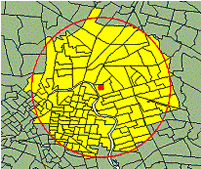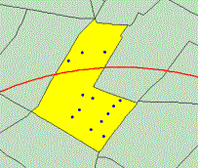The Basic Principle
A geographic retrieval methodology determines how data is gathered and summarized or aggregated for each ring. For standard geographic units, such as counties or ZIP Codes, the link between a designated area—a trade area—and its attribute data is a simple one-to-one relationship; if a trade area contains a selection of ZIP Codes, the data retrieval is a simple process of gathering the data for those ZIP Codes.
The geographic retrieval process for rings is more complicated, because a ring may transect a geographic unit such as a county or ZIP Code. How much of a geographic unit must fall inside the ring for it to be included in the data? Can the aggregation include only data for that portion of the geographic unit that falls inside the ring? There are two approaches to solving this dilemma—Simple Block Group retrieval and Weighted Block Centroid retrieval.
Simple Block Group Retrieval
To produce a report of data for these areas, underlying geographic areas must be collected. The most basic method for aggregating data for trade areas is to use a point-in-polygon approach to gather the census block groups within the trade area and aggregate the data for the block groups.
This map illustrates a store location within a ring with a one-mile radius. The highlighted polygons within the ring represent all the block groups within the trade area selected by the point-in-polygon procedure. By using a Simple Block Group Retrieval methodology, the population of each selected block group would be aggregated to create a trade area total.

Why Simple Block Group Retrieval Is Inaccurate
This map shows a more detailed view of two specific block groups from the map shown above. The block group highlighted in yellow (340030473003) illustrates the fundamental weakness of using block groups exclusively in a point-in-polygon approach. Because the centroid of the polygon is within the one-mile radius, the entire block group is included in the aggregation. For example, if a user calculates population for the one-mile radius trade area, the entire population of the highlighted polygon is included in the total even though approximately half of the block group is outside the trade area. This assignment weakness can severely skew the results of a trade area aggregation, because many block groups contain a large population.

The inverse of this apportionment problem also contributes to the inaccuracy of this geographic retrieval approach. In the same example, the map above shows a portion of block group 340030614001 within the trade area ring. However, none of the block group's attributes will be utilized during the aggregation process. This can have a significant effect on the aggregation process and contributes to inaccurate information on demographic reports.
Why Weighted Block Centroid Retrieval Is Better
Esri employs more sophisticated geographic retrieval methodology to aggregate data for rings and other polygons. The Weighted Block Centroid retrieval approach uses census block data to better apportion block groups that are not exclusively contained within a ring.
Census blocks are the smallest unit of census geography. They are used to create all other levels of census geography. For example, one or many blocks are aggregated to create a block group. In the map to the right, the blue dots represent the geographic centroids for the 13 blocks that make up the yellow highlighted block group. Only a small subset of data (households, population, housing units, and number of businesses) is available at the census block level and, therefore, cannot be used to aggregate most data for a ring.
Using block centroids within a trade area to calculate a weight for a block group allows you to use the Weighted Block Group to more accurately gather and aggregate demographic data for rings and other polygons.
